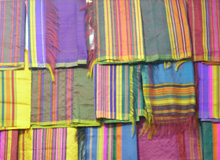Two years ago, Malalai Jawad was an aspiring entrepreneur eager to get the scarves she made from local raw silk into the Ghanavi Market in Kabul, Afghanistan. Jawad now credits the Goldman Sachs 10,000 Women program — run by the Thunderbird School of Management in Glendale, Ariz., and the American University of Afghanistan in Kabul — for providing her with the business know-how to compete against other shops that carry low-cost imports from Iran, Pakistan and China. Jawad’s most valuable takeaway for business survival: product diversification. When she first opened her business in August 2009, she had sales of about $800 USD a month. Today, her sales have nearly doubled.
Amanda Bullough, assistant professor of entrepreneurship at Thunderbird and academic director of the 10,000 Women initiative in Afghanistan, realized early on that she needed to incorporate the topic of diversification into the program’s curriculum. Simply selling one type of product, no matter how unique, would not guarantee business success.
Price over Quality
Soon after Jawad opened Helala Silk Production Sales Center with the help of a grant from Sabre International, she noticed that despite her store being located in Shar-e-Naw, one of Kabul’s nicest shopping areas, most customers were too poor to buy high-quality silk scarves. “Products from other countries use mixed silk, but my products use raw silk and that makes a big difference in quality,” says Jawad, adding that her customers can see and touch scarves of different qualities when they enter her store. Nevertheless, for customers with little money to spend, the focus was on price rather than on quality. “I recognized that most people would not buy a silk shawl because it is expensive and not easy to wear. In addition, customers would ask about jackets, so I began producing ones that mixed traditional and modern styles.”
Jawad used customer feedback to identify additional items to carry and then conducted a feasibility analysis, which involves doing market research, examining potential buyers, identifying the competition and analyzing a business’s finances to determine if it makes sense to add a new product to the mix. “One of the fundamentals in finance is teaching how to find a break-even point and a point of profit margin,” says Bullough. These skills, she adds, also help women examine where they can cut costs in their businesses and what items they can find for cheaper prices. Jawad learned not only how to manage money, but also how to develop a clear plan for what to do with profits. Such knowledge helped her set aside money to reinvest into new items like jackets — thus enhancing her diversification plan.
Profitability is paramount, notes Bullough, who says that as women in the 10,000 Women class get to know each other’s businesses, they begin to recommend customers to each other, which is something she would like to see happen outside the classroom as well. Bullough has discovered that many small businesses in developing countries that sell the same items undercut their competitors. “Rather than sell the same merchandise, we try to teach scholars to set up a referral network.”
Targeting Foreign Markets
Jawad says her goal is to secure more funding so she can grow and find more markets in the provinces of Afghanistan and internationally. She is hoping for help from the Afghan government, which she believes could be offering much more assistance, both financially and strategically, to entrepreneurs. Jawad suggests limiting imports from China, India, Iran and Pakistan, where production costs are often lower, allowing companies there to sell at prices which Afghan business owners can’t compete with. She draws on the example of a small company in Herat that made car batteries. While the Afghan company was able to produce car batteries of equal quality, Iranian companies were able to drop their prices by nearly 50%. It was just a matter of time before the local company lost market share and went out of business.
Many Afghan businesses also import their raw materials rather than buy them locally. In order to grow these markets within Afghanistan, Jawad suggests that the Afghan government increase taxes on local businesses that import such materials.
Tamara Myatt, senior program manager of the 10,000 Women initiative in Afghanistan, agrees that many imports should be blocked. She likewise draws attention to Chinese businesses that are able to replicate local goods, and cites the need for better quality control. Low-quality versions of Afghan products, such as scarves, clothes, accessories, handicrafts and electronics, are constantly flooding the market at cheaper prices. “It is a major problem that needs global attention. It is happening not just in Afghanistan, but in many other developing nations where it is shattering economies for small business owners,” says Myatt, who plans to meet with Afghan officials from the Chamber of Commerce and the Ministry of Economy to discuss the issue.
In the meantime, Myatt is encouraging 10,000 Women scholars such as Jawad to target foreign markets that would not necessarily be interested in purchasing lower-end Chinese products. For example, she has advised Jawad to produce more fitted jackets that would attract international buyers. Already, Jawad has developed a clientele of foreign workers in Kabul who frequent Helala Silk Production Sales Center for their favorite styles.


